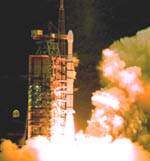 |
China Launches Meteorological Satellite

China Successfully Launches Fengyun 2 Meteorological Satellite
|
China successfully launched a meteorological satellite in Xichang at 7:50 p.m. (Beijing time) Sunday.
The satellite, called the Fengyun 2, was launched by a Long March 3 carrier rocket at the Xichang Satellite Launch Center in southwest China's Sichuan Province.
This is China's second geostationary meteorological satellite. It is an improved version of the first Fengyun 2 meteorological satellite launched by China in 1997, Chinese experts said. The satellite has a designed life span of three years.
The rocket, measuring 44.9 meters in length, has a boosting capacity of 300 tons. It was designed by Chinese scientists. This is the thirteenth launch of a Long March 3 carrier rocket and the sixty-first launch of Long March carrier rocket series.
The satellite successfully entered its final orbit at a perigee of 204 km, apogee of 36,035 km. It will ultimately be positioned in a geostationary orbit over 105 degrees east longitude.
The satellite is expected to play an important role in helping improve medium- and long-term weather forecasts and those for natural disasters in the country and in monitoring the ecological environment in western China, according to officials.
The Fengyun 2 satellite was jointly developed by the Shanghai Aerospace Technology Research Institute under the China Aerospace Corporation, the Chinese Research Institute of Space Technology and several other research institutes.
The satellite is equipped with a scanning radiometer, a cloud coverage information system, a data collection translator, and other high-tech equipment. It is capable of monitoring the Earth's meteorological conditions round-the-clock.
The Fengyun 2 can provide meteorological information such as cloud maps and wind movements.
It can also coordinate the geostationary applications system, including the collection of visible light, infrared rays and water vapor images, as well as the transmission of photos of cloud formations, data collection and environmental monitoring.
China launched two Fengyun 1 weather satellites in 1988 and 1990 respectively. Those two satellites, all sun-synchronous orbit satellites, have stopped functioning.
Now China has become the third country, following the United States and Russia, to develop and launch the weather satellites with the two kinds of orbits.

In This Section

|